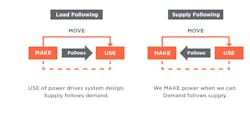An Approach for Evaluating Non-Wires Alternatives
Before we dive into describing an approach for assessing non-wires alternatives (NWAs), let’s start with a description of what they are, instead of what they are not.
NWAs are an approach to grid upgrades that are not centered around installing or upgrading existing wire infrastructure.
But what does that mean?
The IEEE PES Grid Vision 2050 report discusses the transition from today’s load-following paradigm, where we dispatch generation to balance load, to a future state where there exists a supply-following paradigm. Under this scenario, load (the sum total of power demand) is used to match up with available generation. This report also introduced a starkly simple model of the grid:
- Make
- Move
- Use
Simply put, these are the tools we have for managing the grid. We can make electricity. We can move electricity. And we can use electricity.
A conventional solution to grid upgrades involves avoiding, or at least minimizing, any constraints for moving power. In other words, adequate capacity must be built and maintained within all the equipment in the chain from generation to distribution feeder circuits.
We use lines to move power, so can we take the position that a non-wires solution needs to involve making and using electricity? Can it be that simple? If so, what types of solutions can we employ to do that and what types of problems can they help solve?
If we make electricity, it has to go somewhere, so it needs to move where it can be used. If we eliminate the movement of power from the paradigm, the generation and loads need to be relatively close to each other. In other words, we are looking at local electricity markets and other ways of having electricity sinks and sources. This means we’re looking at storage.
We have traditionally designed grids for peak use, so if we need new lines, how can markets help?
There are many potential benefits that deserve discussion, but perhaps highest on that list are the important benefits that can be realized through local dynamic balancing. That benefit is flexibility.
The impacts of today’s wave of electrification are difficult to predict over the long term. The prospect of electrification of even 40% of our transportation fleet creates many scenarios for grid capacity planning, notwithstanding all the other elements of electrification, including two-way power flows. So, if we select a conventional “putting-steel-in-the-ground” approach, do we want to risk being back in the same position within a few years, trying to right-size infrastructure assets?
Under the traditional, conventional approach, it will be inevitable that the model will become “go big or go home.”
But how can we justify the sizing and why make incremental increases when NWAs could handle the increased load?
If the edge of the grid is going to continue to evolve, then utilities must be able to react and respond. That sounds a lot like flexibility needs to be the prime consideration. But before we jump the gun, we need to go back and explore some of the challenges facing utilities today. We need an approach for determining if NWAs are a potential solution to be evaluated, and if so, how they stack up against conventional solutions.
And that brings up an interesting point: should we be calling these NWAs or non-wires solutions? Both are terms that are being used extensively. Ultimately, the solution is what you choose to implement — but before you can choose a solution you need an approach for examining alternatives and that is what we will address in subsequent articles.
About the Author
Mark Knight
Mark Knight is a principal consultant for the energy and utility industries at 1898 & Co., part of Burns & McDonnell. With more than 30 years of experience working for utility companies in the U.K. and the U.S. and as a consultant in the electric supply industry, he is focused on building comprehensive strategies that will improve business and technology solutions for clients. Mark is chairman emeritus of the GridWise Architecture Council and a member of the Institute of Asset Management (IAM). He has participated in several IAM teams to develop asset management guidelines.
Lucas McIntosh
PE, LEED AP
Lucas McIntosh PE, LEED AP, is managing director of advisory consulting at 1898 & Co., part of Burns & McDonnell. He specializes in technical and economic evaluation; data analytics and project management of utility projects and programs; and business strategy and consulting. With a background in mechanical engineering, Lucas has over 14 years of experience, including lead implementation of enterprise back office systems; smart grid pilot project implementation oversight and management; technology performance evaluation, data tracking and analytics; and technology investment business cases.
Jackson Cutsor
Jackson Cutsor is an analyst with 1898 & Co., part of Burns & McDonnell.
Dan Ernstmann
Dan Ernstmann is a lead analyst with 1898 & Co., part of Burns & McDonnell.


